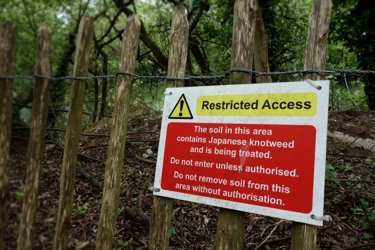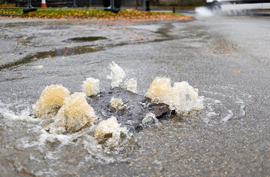How invasive non-native species can threaten biodiversity projects
Published: 17 May 2021
By: Will Greenacre, Consultant Ecologist
Invasive non-native species (INNS) impact native species, threatening biodiversity with serious consequences for entire ecosystems. Climate change can have a huge impact on native species as habitats change allowing INNS to thrive. When building a net-zero or decarbonisation strategy, it is important to survey your land for evidence of INNS which could threaten any future biodiversity projects. Will Greenacre, Consultant Ecologist at Adler and Allan explains how knowing the ecology of your site means you can identify and mitigate any issues such as INNS to avoid impacts to biodiversity and ensure environmental compliance.
An INNS is any non-native flora and fauna introduced outside its natural distribution range which can cause damage to the environment, the economy, our health, and the way we live. The cost of managing INNS in England is estimated at £1.3 billion per year.
The effect of INNS are often overlooked and masked by pressures such as increased nutrients. We need to do more to recognise the impacts of INNS and understand where INNS are stopping the environment from improving in the way we expect when we address other pressures.
Legislative responsibility
Landowners have a legal responsibility to protect habitats and biodiversity of their land, including controlling the spread of INNS through identifying and undertaking appropriate management.
If an operator is responsible for a sensitive site or habitat, they need to understand the risks and constraints to ensure that flora and fauna is protected.
Understand your site’s ecology
It is imperative to understand the ecology of your site and in the first instance to identify presence of INNS. A comprehensive environmental site audit from Adler and Allan’s ecologists will ensure strategic management of the sites’ habitats, flora and fauna and advise on appropriate control measures if INNS are present. Ensuring the operator has a ‘full picture’ of their site’s ecology will ensure they are aware of legislative requirements and operations are environmentally compliant.
Pathways of transmission
Human activities, whether intentional or unintentional are the main cause of transmission of INNS into the wild.
Intentional release
Japanese knotweed (Fallopia japonica) is a commonly known rapid spreading invasive non-native plant, that was introduced to Britain as an ornamental garden plant in the 1800s. It has now become established across much of the UK threatening biodiversity, causing huge economic strain to control and legislative/financial implications for infrastructure, commercial and domestic properties.
Un-intentional release
This type of spread can occur through lack of awareness and poor biosecurity. Landowners may be unaware of INNS on their property and inadvertently extend the range of the species at their site, or cause spread to another property through business activities, which may have legal implications. The potential pathways of transmission should be identified at all sites and will vary widely depending on the site activities, habitats and surrounding environmental influences.
A benchmark in the event of an INNS occurrence
If an operator suffers an INNS occurrence, then it is likely that the habitat will need to be fully restored – at their cost and with unknown damage to their reputation – so it is really important that they have clear benchmark information. Doing regular surveys helps to demonstrate to the regulators and developers that the operator is taking their responsibilities seriously and proactively (which can help to mitigate or even avoid regulatory action) and support the acquisition or selling process a well as providing clarity if restoration is required.
Prevention is better than cure
Preventing the arrival and spread of INNS is the priority, as most species are difficult or impossible to deal with once they are established. The most effective way of preventing the introduction and spread of INNS is to apply good biosecurity. We can work with you to ensure your activities are more bio-secure by focusing on the key pathways by which INNS arrive and spread.
Restoring habitats. Identify, Mitigate, Manage
Our ecologists can provide a programme of relatively inexpensive walkover surveys which lead to early intervention when INNS, saving the operator expense and reputational damage (such as this example) if invasive plants have become established and spread. They can support with control and eradication when INNS are identified as well as remediation strategies.

More from our Knowledge Hub
 News
NewsCelebrating and supporting our veterans at the Forces in Business Awards 2025
 Insights
InsightsRebuilding trust in water: Interim recommendations from the Independent Water Commission
 Insights
InsightsMitigating the impact of the 4 ‘I’s to reduce pollution in water networks
 News
NewsEsh Construction secures Northumbrian Water repairs and maintenance framework
Environmental compliance today, creating a sustainable tomorrow
Helping you reduce risk to the environment and your operation by managing assets compliantly while achieving commercial, ESG, and net-zero goals.
Contact our experts
